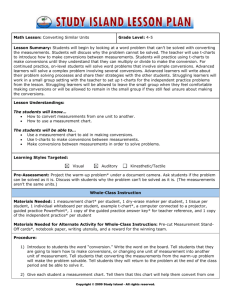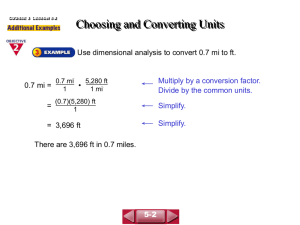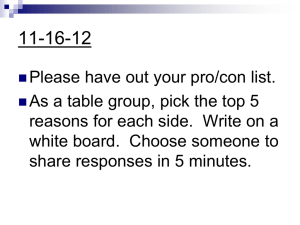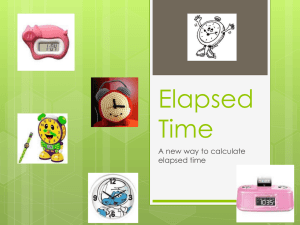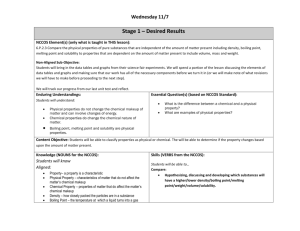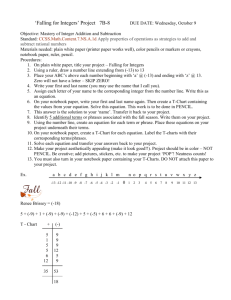Converting Measurements
advertisement
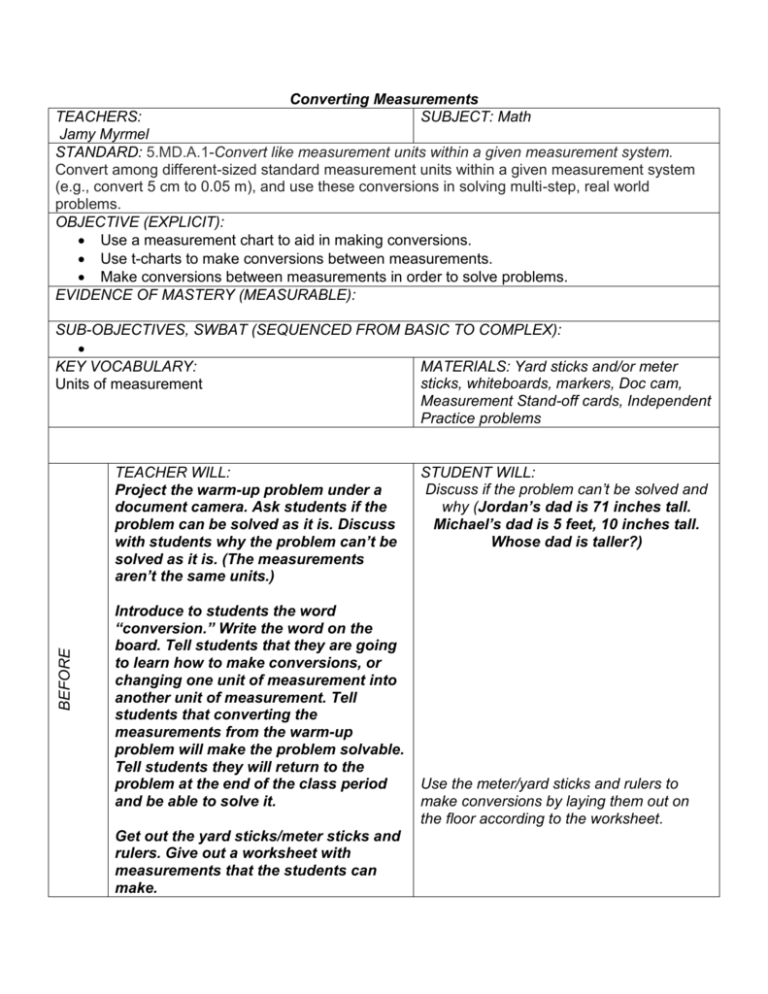
Converting Measurements SUBJECT: Math TEACHERS: Jamy Myrmel STANDARD: 5.MD.A.1-Convert like measurement units within a given measurement system. Convert among different-sized standard measurement units within a given measurement system (e.g., convert 5 cm to 0.05 m), and use these conversions in solving multi-step, real world problems. OBJECTIVE (EXPLICIT): Use a measurement chart to aid in making conversions. Use t-charts to make conversions between measurements. Make conversions between measurements in order to solve problems. EVIDENCE OF MASTERY (MEASURABLE): SUB-OBJECTIVES, SWBAT (SEQUENCED FROM BASIC TO COMPLEX): KEY VOCABULARY: MATERIALS: Yard sticks and/or meter sticks, whiteboards, markers, Doc cam, Units of measurement Measurement Stand-off cards, Independent Practice problems BEFORE TEACHER WILL: Project the warm-up problem under a document camera. Ask students if the problem can be solved as it is. Discuss with students why the problem can’t be solved as it is. (The measurements aren’t the same units.) Introduce to students the word “conversion.” Write the word on the board. Tell students that they are going to learn how to make conversions, or changing one unit of measurement into another unit of measurement. Tell students that converting the measurements from the warm-up problem will make the problem solvable. Tell students they will return to the problem at the end of the class period and be able to solve it. Get out the yard sticks/meter sticks and rulers. Give out a worksheet with measurements that the students can make. STUDENT WILL: Discuss if the problem can’t be solved and why (Jordan’s dad is 71 inches tall. Michael’s dad is 5 feet, 10 inches tall. Whose dad is taller?) Use the meter/yard sticks and rulers to make conversions by laying them out on the floor according to the worksheet. DURING TEACHER WILL: Give each student a measurement chart. Tell them that this chart will help them convert from one unit of measurement to another. Tell them that they are going to use a t-chart as a strategy to help them convert from one measurement to another. Pose the question, “How many quarts are in 6 gallons?” Draw a t-chart on the board. See example t-chart, if necessary. Label the left side “gallons” and the right side “quarts.” Have students draw the same t-chart on their whiteboards. Ask students to look at their measurement charts and find the relationship between quarts and gallons. Choose a student to identify the relationship. Write 4 quarts equals 1 gallon on the t-chart. Ask students how many quarts would be in 2 gallons, and write 2 gallons on the t-chart. Elicit responses. Record 8 quarts on the tchart. Ask students how they knew the answer was 8 quarts. Elicit responses. Students may say they added 4 quarts + 4 quarts. Lead students to see that they can multiply 2 gallons x 4 quarts. Now write 6 gallons on the t-chart. Ask students how they can figure out how many quarts are equal to 6 gallons. Elicit responses. Show the multiplication problem 6 x 4 on the t-chart. Pose the question, “How many yards are equal to 27 feet?” Draw a new t-chart on the board. Label the left side “yards” and the right side “feet.” Have students erase the t-chart from the previous STUDENT WILL: Create a T-chart on their whiteboards to solve conversions. activity and copy the new t-chart on their whiteboards. Ask students to look at their measurement charts and find the relationship between feet and yards. Choose a student to identify the relationship. Write 1 yard equals 3 feet on the t-chart. Ask students how many yards are in 6 feet. Record 6 feet on the t-chart. Elicit responses, asking the student to explain how s/he got 2 yards as the answer. Lead students to see that Solve real world problems using the TChart to convert units of measurement. they can divide the number of feet by 3 to find the number of yards. Have students write 27 feet on the t-chart. Ask students to divide by 3 to find the corresponding number of yards. Elicit answers from students. Record 9 yards on the t-chart. Tell students that since they have learned how to use multiplication and division to convert, or change, one unit of measurement into another, they will now use this skill to solve some word problems on their whiteboards. CO-TEACHING STRATEGY IF APPLICABLE AFTER TEACHER WILL: This game can be used instead of the independent practice or as a test review. Prior to playing Measurement Stand-off, copy the game cards and cut them apart. Place them in a stack face down so that the questions are not visible. Divide students into 4-5 teams. Give each student a copy of the measurement chart and a piece of notebook paper to use as scratch paper. Tell students they will be playing a game called Measurement Stand-Off. Explain the rules of the game to students. A representative from one team will choose a question from a stack. The teacher will project the card under the document camera for all students to STUDENT WILL: Play Measurement Stand-off in groups. see. The question will show two measurements. If the team is able to correctly choose the larger measurement and explain how it found the correct answer, the team will be rewarded points based on the difficulty of the question. If the team does not correctly choose the larger measurement or is unable to explain how it found the answer, the team does not receive any points. Play continues until there are no more cards. When all cards have been played, the teacher will tell students it’s time for the Bonus Round. Each team must agree on an amount of their points they want to wager. The team may not wager more points than they have earned. Warn students that the Bonus Round question is very challenging. Each team who gets the Bonus Round question correct will earn as many points as they wagered. Each team who gets the Bonus Round Question incorrect will lose that many points. The team with the highest amount of points after the Bonus Round will earn a reward. Measurement Stand-Off Cards Independent Practice
